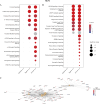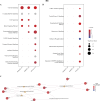Nighttime-specific differential gene expression in suprachiasmatic nucleus and habenula is associated with resilience to chronic social stress
- PMID: 39358331
- PMCID: PMC11447250
- DOI: 10.1038/s41398-024-03100-w
Nighttime-specific differential gene expression in suprachiasmatic nucleus and habenula is associated with resilience to chronic social stress
Abstract
The molecular mechanisms that link stress and biological rhythms still remain unclear. The habenula (Hb) is a key brain region involved in regulating diverse types of emotion-related behaviours while the suprachiasmatic nucleus (SCN) is the body's central clock. To investigate the effects of chronic social stress on transcription patterns, we performed gene expression analysis in the Hb and SCN of stress-naïve and stress-exposed mice. Our analysis revealed a large number of differentially expressed genes and enrichment of synaptic and cell signalling pathways between resilient and stress-naïve mice at zeitgeber 16 (ZT16) in both the Hb and SCN. This transcriptomic signature was nighttime-specific and observed only in stress-resilient mice. In contrast, there were relatively few differences between the stress-susceptible and stress-naïve groups across time points. Our results reinforce the functional link between circadian gene expression patterns and differential responses to stress, thereby highlighting the importance of temporal expression patterns in homoeostatic stress responses.
© 2024. The Author(s).
Conflict of interest statement
The authors declare no competing interests.
Figures






References
-
- Joyce PR, Porter RJ, Mulder RT, Luty SE, McKenzie JM, Miller AL, et al. Reversed diurnal variation in depression: associations with a differential antidepressant response, tryptophan:large neutral amino acid ratio and serotonin transporter polymorphisms. Psychol Med. 2005;35:511–7. - PubMed
MeSH terms
Grants and funding
LinkOut - more resources
Full Text Sources
Medical

